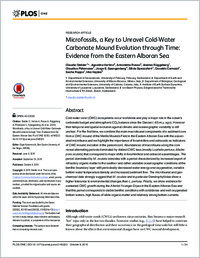Microfossils, a key to unravel cold-water carbonate mound evolution through time: Evidence from the eastern alboran sea
- Stalder, Claudio Department of Geosciences, University of Fribourg, Fribourg, Switzerland
- Vertino, Agostina Department of Earth and Environmental Sciences, University of Milano-Bicocca, Milano, Italy
- Rosso, Antonietta Department of Biological, Geological and Environmental Sciences, University of Catania, Catania, Italy
- Rüggeberg, Andres Department of Geosciences, University of Fribourg, Fribourg, Switzerland
- Pirkenseer, Claudius Department of Geosciences, University of Fribourg, Fribourg, Switzerland
- Spangenberg, Jorge E. Institute of Earth Surface Dynamics, University of Lausanne, Lausanne, Switzerland,
- Spezzaferri, Silvia Department of Geosciences, University of Fribourg, Fribourg, Switzerland
- Camozzi, Osvaldo Department of Geosciences, University of Fribourg, Fribourg, Switzerland
- Rappo, Sacha Department of Geosciences, University of Fribourg, Fribourg, Switzerland
- Hajdas, Irka Ion Beam Physics, Eidgenössische Technische Hochschule ETH Zürich, Zürich, Switzerland
-
08.10.2015
Published in:
- PLoS ONE. - 2015, vol. 10, no. 10, p. e0140223
English
Cold-water coral (CWC) ecosystems occur worldwide and play a major role in the ocean's carbonate budget and atmospheric CO2 balance since the Danian (~65 m.y. ago). However their temporal and spatial evolution against climatic and oceanographic variability is still unclear. For the first time, we combine the main macrofaunal components of a sediment core from a CWC mound of the Melilla Mounds Field in the Eastern Alboran Sea with the associated microfauna and we highlight the importance of foraminifera and ostracods as indicators of CWC mound evolution in the paleorecord. Abundances of macrofauna along the core reveal alternating periods dominated by distinct CWC taxa (mostly Lophelia pertusa, Madrepora oculata) that correspond to major shifts in foraminiferal and ostracod assemblages. The period dominated by M. oculata coincides with a period characterized by increased export of refractory organic matter to the seafloor and rather unstable oceanographic conditions at the benthic boundary layer with periodically decreased water energy and oxygenation, variable bottom water temperature/density and increased sediment flow. The microfaunal and geochemical data strongly suggest that M. oculata and in particular Dendrophylliidae show a higher tolerance to environmental changes than L. pertusa. Finally, we show evidence for sustained CWC growth during the Alleröd-Younger-Dryas in the Eastern Alboran Sea and that this period corresponds to stable benthic conditions with cold/dense and well oxygenated bottom waters, high fluxes of labile organic matter and relatively strong bottom currents
- Faculty
- Faculté des sciences et de médecine
- Department
- Département de Géosciences
- Language
-
- English
- Classification
- Palaeontology
- License
-
License undefined
- Identifiers
-
- RERO DOC 257943
- DOI 10.1371/journal.pone.0140223
- Persistent URL
- https://folia.unifr.ch/unifr/documents/304645
Statistics
Document views: 129
File downloads:
- pdf: 185
